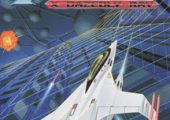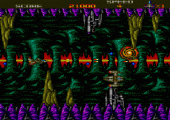Genre: Shmup Developer: Unipac Publisher: Unipac Players: 1 Released: 1990
Picture yourself in 1991, going into a game store or getting a brand new game from your import supplier. Now assume this new game you just bought is called XDR: X-Dazedly-Ray (you don’t know it will be so obscure nobody will care about it in a few years). You can barely contain you excitement. Besides the stylish name, the awesomeness of the cover art leaves you wondering what great goodies are concealed inside that precious plastic box.
As you power up your Mega Drive, you’re treated with a rather unimpressive title. It shouldn’t bother you much, since very good games are presented the very same way. However, as you start to play you slowly realize how big the gap between artwork and actual game design can be sometimes. After all, XDR is a classic example of how to entice a gamer into buying something almost completely devoid of any potential for providing fun.
I have absolutely no idea of what X-Dazedly-Ray means. You can’t figure it out from the game either since there’s no special “ray” or “dazzle” feature in it whatsoever. In fact, it’s quite the contrary. Though varied enough to not let you fall asleep, the graphics do not exhibit any sort of noteworthy aspects. Settings go from city, caves, a temple, some strange lunar and organic landscapes and the obligatory enemy fortress. Shooter fans will definitely recognize the heavy Gradius influence on some bosses, protective barriers and cores included. Regardless of stage design and the lack of graphical excellence, the scrolling in this game is very slow, and a slight sensation of fast action is only achieved when the ship speed is set to the maximum setting. The bad news is that you can’t always do this due to the enormous size of the ship. Most of the challenge is related to adapting yourself to its bulky horizontal length, and it definitely takes some time to successfully maneuver without crashing on obstacles by accident.
Powering up is icon-based and involves three interchangeable main weapons: the beam/vulcan (B), the laser (L) and the wave shot (W). Additionally, it’s also possible to get a shield (S), missiles (M), two tracing options (O) and extra lives (1). The game urges you to turn your ship into a powerhouse and not die, or else you’re screwed. To make things a bit more difficult there’s also the checkpoint system, which splits all six stages into two sections. Scoring is pretty straightforward, with no special mechanics other than killing everything that takes damage. Further loops of the game have stronger enemies, but there seems to be no change in bullet speed/count.
XDR is also remarkable for what I like to name as the incredible “warp from hell.” The bad news about it is that you’ll have to play the whole game in order to know what it’s all about. Due to the game’s extraordinary programming, when you’re fighting the last boss your ship might disappear for no reason and leave you blind for some seconds. A secret boss power or another glaring flaw of an already poor game? Make your choice!
As bland as the gameplay is, it surely doesn’t hurt as much as the uninspired music, which disappointingly joins the muffled array of sound effects. If XDR had a killer or at least a decent soundtrack, it wouldn’t be such an underwhelming experience. A good soundtrack is what helps lift games such as Curse, for example, from the same mediocrity level that plagues XDR.
With the exception of collection completionists, no sane gamer will want to put his/her hands on this title. It’s got almost nothing to offer when compared to other shooters on the same platform, and the little it does isn’t enough to get anyone thrilled. A cool sounding name and a great box art? The Mega Drive library has got plenty of those already, thank you.
SCORE: 2 out of 10










Recent Comments